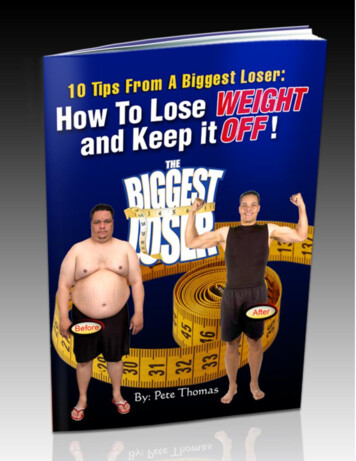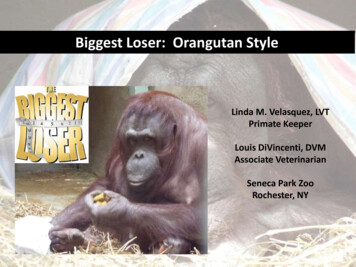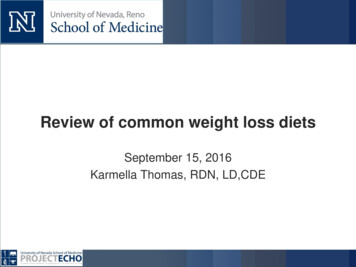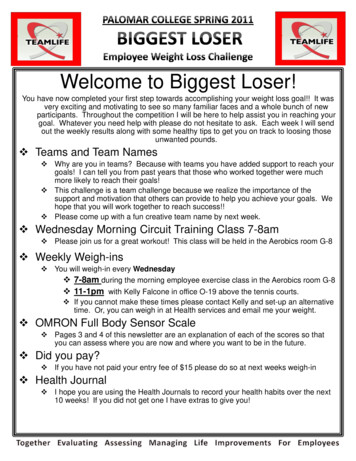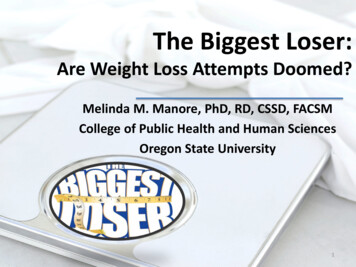
Transcription
The Biggest Loser:Are Weight Loss Attempts Doomed?Melinda M. Manore, PhD, RD, CSSD, FACSMCollege of Public Health and Human SciencesOregon State University1
Today’s Focus1. Biggest Loser – What did we learn?2. Weight loss/Mgt – What can werecommend?3. Rethinking how we talk about weightmanagement.2
1. The Biggest Loser:What have we learned?BeforeAfterBill Germanakos from Biggest Loser3
J Clin Endocrinol Metab, 2012Obesity, 2016Kevin Hall, PhDNIDDKEric Ravussin, PhDPennington Biomedical Research Center
J Clin Endocrinol Metab, 2012Question:1. Does a weight loss program of diet restriction andvigorous exercise preserve FFM and RMR?2. Does metabolic ‘adaptation” occur to counterweight loss and contribute to weight regain?Subjects: Biggest Loser Participants (n 16; M 7; F 9) measuredbefore & after weight loss (0,6,30wk) (33 10y).Methods: Housed in isolated ranch in LA, with 1 contestant votedout every 7-10 d (n 11 at 6wk); 4 stayed for 13 wks. Participantsreturned home & continued program on their own (30 wk).Exercise: 90min/d supervised (6d/wk, aerobic/strength) encourage to do another 3 h/d. Min PA 2h/d; Mean PA 3 h/dDiet: 65-70% of baseline energy requirements (1300 kcal/d).
Body Size/En ExpenditureBaseline (n 16)Week 30 (n 16)Change Body Wt (kg)149.2 (38.0) (330lbs)91.6 (22.9)57.6 kg (127lbs)BMI (kg/m2)49.4 (9.4)30.4 (6.4)19.0Anthropometrics (DXA)Wt Change (%)39.9 (9.1)FFM (kg)75.7(20.2)65.2(15.5)10.5 (17.4% Wt Loss)FM (kg)73.5 (21.1)26.4 (13.8)47.1 (82.6% Wt Loss)49(5)28(10)21%2,679(624)1,890 (423)-789Body Fat (%)Energy ExpenditureRMR (kcal/d)Predicted RMR (kcal/d)2,393 (466)Metabolic Adapt (kcal/d)TEE (kcal/d)3900 (957)-504 (171) (n 14)(7% kcal/kg FFM)3114 (571)-7866
Body Size/En ExpenditureBaseline (n 16)Week 30 (n 16)Change Body Wt (kg)149.2 (38.0) (330lbs)91.6 (22.9)57.6 kg (127lbs)BMI (kg/m2)49.4 (9.4)30.4 (6.4)19.0Anthropometrics (DXA)Wt Change (%)39.9 (9.1)FFM (kg)75.7(20.2)65.2(15.5)10.5 (17.4% Wt Loss)FM (kg)73.5 (21.1)26.4 (13.8)47.1 (82.6% Wt Loss)49(5)28(10)21%2,679(624)1,890 (423)-789 kcal/dBody Fat (%)Energy Expenditure (DLW)RMR (kcal/d) (mea)Predicted RMR (kcal/d) used baseline dataMetabolic Adapt (kcal/d)TEE (kcal/d)3900 (957)2,393 (466)-504 (171) (n 14)(20% kcal/kg FFM)3114 (571)-786 kcal/d7
Metabolic ChangesSignificant Improvements (mean ): Fasting Glucose 19 mg/dl (20%)HOMA-IR 40%*C-Peptide 50%TAG 64 mg/dl (216%)*HDL-Chol 12 mg/dl8
Summary (Baseline-30 wks) Despite FFM preservation, high exercisedid not prevent the slowing of RMRmore than predicted based on weightloss. Metabolic adaptation persisted throughweight maintenance, which mayincrease risk of weight regain unlesshigh level PA maintained andenergy restriction remained.Alan Smith9
Obesity, 2016Kevin HallObjective:1. Measure long-term changes in RMR & bodycomposition in participants of “Biggest Loser”.Subjects: Biggest Loser participants (n 14/16; M 6; F 8) returned to NIH6y after weight loss. 1 subject maintained wt loss; 5 subjects were with 1% ofbaseline or above.Methods: For 2 wk prior to 3-d NIH Clinical Ctr stay, remote body weightmonitoring occurred (bluetooth; electronic). RMR, TEE (DLW) and bodycomposition (DXA), and hormones & metabolite measurements done.Fothergill et al, 2016
Body Size/En Expend. at 6 yN 14BaselineAge 34.9yWeek 30Age 35.4y6yAge 41.3yBody Wt (kg)148.990.6131.6 (87% of baseline)BMI (kg/m2)49.5 (10.1)30.2 (6.7)43.8FFM (kg)75.5(21.1)64.4(15.5)70.2 (93% baseline)FM (kg)73.4 (22.6)26.2 (13.6)61.4 (84% baseline)49(5)28(9)44.7 (91% baseline)5.6 1.810.0 4.610.1 4.0RMR (kcal/d) (mea)2,607(649)1,996 (358)1,930 (466)Predicted RMR (kcal/d)2,577 (5742,272 (435)2,403 (507)-275 (205)-499 (207)3,002 (573)3,429 581Anthropometrics (DXA)Body Fat (%)Energy Expenditure (DLW)PA (kcal/kg/d)Metabolic Adapt (kcal/d)TEE (kcal/d)3804 (957)11
Body Size/En Expend. at 6 yN 14BaselineAge 34.9yWeek 30Age 35.4y6yAge 41.3yBody Wt (kg)148.990.6131.6 (87% of baseline)BMI (kg/m2)49.5 (10.1)30.2 (6.7)43.8FFM (kg)75.5(21.1)64.4(15.5)70.2 (93% baseline)FM (kg)73.4 (22.6)26.2 (13.6)61.4 (83% baseline)49(5)28(9)44.7 (91% baseline)5.6 1.810.0 4.610.1 4.0RMR (kcal/d) (mea)2,607(649)1,996 (358)1,930 (466)Predicted RMR (kcal/d)2,577 (5742,272 (435)2,403 (507)-275 (205)-499 (207)3,002 (573)3,429 581Anthropometrics (DXA)Body Fat (%)Energy Expenditure (DLW)PA (kcal/kg/d)Metabolic Adapt (kcal/d)TEE (kcal/d)3804 (957)12
Individual BW, FFM & FMBody WeightFat Free MassFat MassRegained FFMFat Mass Gains13
Individual RMR & MetabolicAdaptation RMR14
Who experienced the most metabolicadaptation?1. Weight regain was not significantly correlated withmetabolic adaptation.2. Subjects who maintained weight loss at 6 y experiencedthe greatest metabolic adaptation.Wt regained from Baseline15
Biggest Loser Summary1. Participants regained 87% of theirlost weight in 6 y. UNSUCCESSFUL?2. 50% of participants maintained atleast a 10% weight loss. SUCCESS?3. Metabolic adaptation was NOTrelated with weight regain – but withlong-term weight loss.4. Long-term weight loss requiresvigilant combat against weight regain.16
2. Weight Loss – What can werecommend?Diet Exercise vs Diet?
PLoS One, 2009Subjects: M/W (n 48); Age: 38y; BMI 27.8(kg/m2); 2d/wk PADiet: (TEE determined by DLW over 14-d); Wk 1-12 & 22-24 all foodprovided; Wks13-22 self-selected diets based on targets; 30% FAT;15% PRO; 55% CHO Control (ad libitum diet);Caloric restriction (CR) ( 25% of en);CR ( 12.5% en) Ex ( 12.5% en; 5d/wk, 45-55 min/d using HRM)Low calorie diet (LCD) 890 kcal/d until lost 15% BW thenmaintenanceDuration: 6 monthsData collection body comp (DXA): baseline, 3, 6.
CR 25%CR EX 12.5% eaLCD 900 kcal/d6 mo 25% enKey point: Weight loss the same with CR (-10.4% ) and CR EX (-10% ).
CR Exercise 129 86CR 25%CR EX 12.5% eaLCD 900 kcal/dCaloric Restriction only-240 114 kcalRedman et al PLoS 2009
Dr. Barbara Rolls, Distinguished ProfessorPenn State UniversityAuthor: “Volumetrics Weight-Control Plan: Feel Full on Fewer Calories” &“The Volumetrics Eating Plan”
Low Energy Density (LED) (kcal/g) DietTypes of Foods: Whole fruitsWhole VegetablesHigh fiber whole grainsLow fat foods (dairy/meat)¼ c raisins vs.1 2/3 c grapesCharacteristics of FoodsHigh fiber & water content High volume/weight Less energy (kcal) per weight (g)of food (kcal/g) Aid in satiety & promote feelingof fullness Low in fat; no sweetened bevSummary: LED diets may resultgreater losses in BW & reduction inkcals with no reduction in portionsizes. Rolls et al, 2004
Results:Portion Size Effects: 231 kcal/d; 10% kcal2006, AJCN.Energy Density Effects:-575 kcal/d; 24% kcals
Examples of very low, low, medium,and high energy dense foodsVery-low( 0.6 kcal/g)Low(0.6-1.5 kcal/g)Most whole fruits,berriesOther fruits:bananas, papayasMost wholevegetablesStarchy vegetables:peas, corn, wintersquash, bakedpotatoFat-free cottagecheeseSkim milk; low-fatyogurt/dairyBroth based soupsCooked wholegrains:(oatmeal,brown rice)Legumes, low-fatmeatsMedium(1.5-4.0 kcal/g)Dried fruits:apricots, raisins,applesWhole wheat (WW)breads, bagels,English muffinsHigh( 4.0 kcal/g)Nuts and nutbuttersCookies, muffins,pastries; foods withadded sugar and fatMozzarella or Swiss Other cheesescheddar, Brie-,cheesemayo, sour creamBaked snackPotato chips,foods: pretzels,regular tortillatortilla chipschips, pretzelsEggs, sirloin steak, Candy-all types,24pork chopschocolate
Challenges to Weight Mgt Recommendations from ACSM Position Paper forWeight Control for adults (Donnelly et al. MSSE 2009): Prevent weight gain 150-250 min/wk (20-35 min/d) Improve weight loss 150-250 min/wk (20-35 min/d) moderate energy restriction Keep weight off after dieting 250 min/wk 3-5% in wt can significant CHD factorsPeople who lose wt and keepoff typically exercise at least1h/day (NWCR data). 1it
3. Surviving our obesogenicenvironment? Weight management is difficult in today’sfood/built environment. Identify what you can manipulate & understandwhat you cannot change. Identify a weight that is ‘healthy’ and allows youparticipate in physical activities. Remember your diet & PA level is the sum totalof the small everyday choices you make!
Thank you! Questions?
Feb 23, 2017 · 1. Does a weight loss program of diet restriction and vigorous exercise preserve FFM and RMR? 2. Does metabolic ‘adaptation” occur to counter weight loss and contribute to weight regain? Subjects: Biggest Loser Participants (n 16; M 7; F 9) measured befo
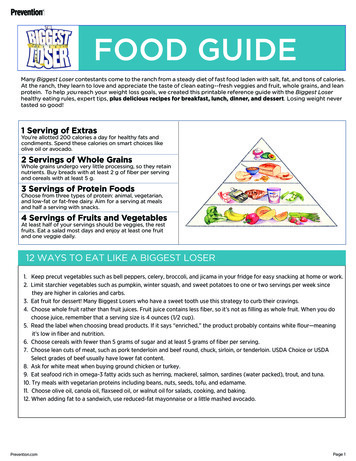
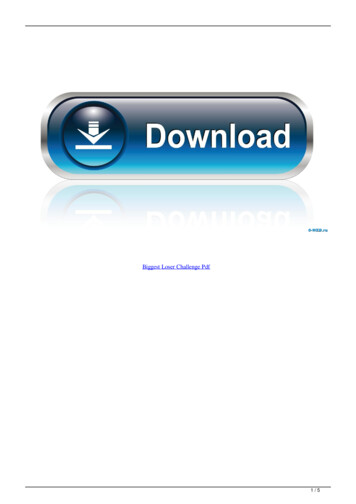
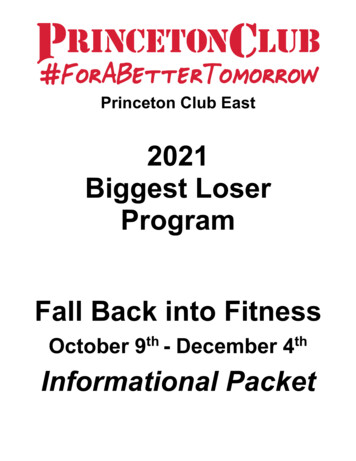


![Index [cdn.etechgs ]](/img/20/july-2018-newsletter1.jpg)
